National Gallery of Art West Building West Garden Court
 | |
 | |
| Location in Washington, D.C. Testify map of Washington, D.C. National Gallery of Art (the United States) Show map of the United States | |
| Established | 1937 (1937) |
|---|---|
| Location | National Mall between 3rd and ninth Streets at Constitution Avenue NW, Washington, DC, 20565, National Mall, Washington, D.C. |
| Coordinates | 38°53′29″N 77°01′12″W / 38.89139°N 77.02000°W / 38.89139; -77.02000 Coordinates: 38°53′29″N 77°01′12″W / 38.89139°Northward 77.02000°W / 38.89139; -77.02000 |
| Collection size | 75,000 prints |
| Visitors | i,704,606 (2021) - Ranked 6th globally[one] |
| Manager | Kaywin Feldman |
| President | Mitchell Rales |
| Chairperson | Sharon Rockefeller |
| Public transit access | Metrobus: 4th Street and seventh Street NW DC Circulator: quaternary Street and Madison Drive; 9th Street and Constitution Avenue NW |
| Website | nga.gov |
The National Gallery of Art, and its attached Sculpture Garden, is a national art museum in Washington, D.C., United States, located on the National Mall, betwixt 3rd and 9th Streets, at Constitution Artery NW. Open to the public and free of accuse, the museum was privately established in 1937 for the American people by a joint resolution of the United states Congress. Andrew Due west. Mellon donated a substantial art drove and funds for construction. The core collection includes major works of art donated by Paul Mellon, Ailsa Mellon Bruce, Lessing J. Rosenwald, Samuel Henry Kress, Rush Harrison Kress, Peter Arrell Browne Widener, Joseph E. Widener, and Chester Dale. The Gallery'south collection of paintings, drawings, prints, photographs, sculpture, medals, and decorative arts traces the evolution of Western Art from the Middle Ages to the nowadays, including the only painting by Leonardo da Vinci in the Americas and the largest mobile created by Alexander Calder.
The Gallery'due south campus includes the original neoclassical West Building designed by John Russell Pope, which is linked secret to the modern East Building, designed by I. Chiliad. Pei, and the 6.one-acre (25,000 grand2) Sculpture Garden. The Gallery often presents temporary special exhibitions spanning the world and the history of art. It is ane of the largest museums in N America.
For the breadth, scope, and magnitude of its collections, the National Gallery is widely considered to be i of the greatest museums in the United States of America, frequently ranking alongside the Metropolitan Museum of Art and Museum of Modern Fine art in New York Metropolis, the Art Constitute of Chicago in Chicago, Illinois, and the Museum of Fine Arts in Boston, Massachusetts. Of the top 3 art museums in the United States by annual visitors, information technology is the only one that has no admission fee. in 2021 it attracted 1,704,606 visitors, and ranked fifth on the listing of most visited art museums in the globe.[ii]
History [edit]
Origins [edit]
Andrew Due west. Mellon, Pittsburgh broker and Treasury Secretarial assistant from 1921 until 1932, began gathering a private collection of quondam master paintings and sculptures during Earth War I. During the late 1920s, Mellon decided to direct his collecting efforts towards the institution of a new national gallery for the The states.
In 1930, partly for revenue enhancement reasons, Mellon formed the A. W. Mellon Educational and Charitable Trust, which was to exist the legal owner of works intended for the gallery. In 1930–1931, the Trust fabricated its first major conquering, 21 paintings from the Hermitage Museum in Leningrad as part of the Soviet sale of Hermitage paintings, including such masterpieces as Raphael'south Alba Madonna, Titian's Venus with a Mirror, and Jan van Eyck's Annunciation.
In 1929 Mellon had initiated contact with the recently appointed Secretary of the Smithsonian Institution, Charles Greeley Abbot. Mellon was appointed in 1931 as a Commissioner of the Establishment's National Gallery of Fine art. When the director of the Gallery retired, Mellon asked Abbot not to engage a successor, as he proposed to endow a new building with funds for expansion of the collections.
Nevertheless, Mellon'southward trial for tax evasion, centering on the Trust and the Hermitage paintings, acquired the plan to be modified. In 1935, Mellon announced in The Washington Star his intention to constitute a new gallery for quondam masters, carve up from the Smithsonian. When asked past Abbot, he explained that the project was in the easily of the Trust and that its decisions were partly dependent on "the attitude of the Government towards the gift".
In January 1937, Mellon formally offered to create the new Gallery. On his birthday, 24 March 1937, an Act of Congress accustomed the collection and edifice funds (provided through the Trust), and approved the construction of a museum on the National Mall.
The new gallery was to be finer self-governing, not controlled past the Smithsonian, but took the erstwhile proper noun "National Gallery of Fine art" while the Smithsonian'southward gallery would be renamed the "National Collection of Fine Arts" (now the Smithsonian American Art Museum).[3] [4] [five]
Construction and later history [edit]
The museum stands on the onetime site of the Baltimore and Potomac Railroad Station, where in 1881 a disgruntled office seeker, Charles Guiteau, shot President James Garfield (see James A. Garfield assassination).[vi] The station was demolished in 1908 because it did non conform to the McMillan Plan for the Mall. In 1918, temporary war buildings were constructed on the site; these were demolished by 1921 to construct the foundation of the George Washington Memorial Building, which was never completed. The site was then reassigned to the new National Gallery of Art.[seven]
Designed past architect John Russell Pope, the new structure was completed and accepted by President Franklin D. Roosevelt on behalf of the American people on March 17, 1941. At the time of its inception it was the largest marble structure in the earth. Neither Mellon nor Pope lived to see the museum completed; both died in late August 1937, just ii months afterwards excavation had begun.[6]
Equally predictable by Mellon, the creation of the National Gallery encouraged the donation of other substantial fine art collections by a number of private donors. Founding benefactors included such individuals as Paul Mellon, Samuel H. Kress, Rush H. Kress, Ailsa Mellon Bruce, Chester Dale, Joseph Widener, Lessing J. Rosenwald and Edgar William and Bernice Chrysler Garbisch.
The Gallery'south East Building was constructed in the 1970s on much of the remaining land left over from the original congressional action. Andrew Mellon's children, Paul Mellon and Ailsa Mellon Bruce, funded the building. Designed by architect I. M. Pei, the contemporary structure was completed in 1978 and was opened on June 1 of that twelvemonth by President Jimmy Carter. The new edifice was built to house the Museum'southward collection of modern paintings, drawings, sculptures, and prints, as well every bit written report and enquiry centers and offices. The design received a National Honor Award from the American Constitute of Architects in 1981.
The last addition to the complex is the National Gallery of Art Sculpture Garden. Completed and opened to the public on May 23, 1999, the location provides an outdoor setting for exhibiting a number of large pieces from the Museum'due south contemporary sculpture collection.
In 2011, an extensive refurbishment and renovation of the French galleries were undertaken. Every bit part of the celebration of the reopening of this fly, organist Alexander Frey performed 4 sold-out recitals of music of French republic in ane weekend in the French Gallery.
Operations [edit]
The National Gallery of Art is supported through a individual-public partnership. The United States federal government provides funds, through annual appropriations, to support the museum'due south operations and maintenance. All artwork, likewise every bit special programs, are provided through private donations and funds.[8] The museum is not part of the Smithsonian Establishment.
Noted directors of the National Gallery have included David East. Finley, Jr. (1938-1956), John Walker (1956–1968), and J. Carter Brown (1968–1993). Earl A. "Rusty" Powell 3 was named manager in 1993. In March 2019 he was succeeded by Kaywin Feldman, by managing director and president of the Minneapolis Institute of Fine art.[9] [ten] The museum hired Evelyn Carmen Ramos, the start woman and the kickoff person of colour to be the chief curatorial and conservation officer, in 2021.[11]
The president of the museum is billionaire businessman Mitchell Rales and its chairperson is Sharon Rockefeller.[12]
Entry to both buildings of the National Gallery of Art is complimentary of accuse. The museum is open up daily from ten a.thou. – v p.m. It is closed on December 25 and January i.[13]
During the COVID-19 pandemic, the National Gallery was largely airtight to the public. Notwithstanding, visitors were able to schedule appointments to access the w building in small numbers.[14]
Architecture [edit]

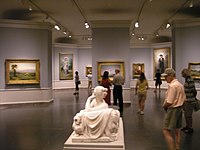
Exhibitions in the Westward Building

Exhibitions in the Due east Building

Walkway to West Edifice and Pour Buffet in National Gallery of Fine art, Washington.D.C.
The museum comprises two buildings: the West Building (1941) and the E Edifice (1978) linked past an underground passage. The W Building, equanimous of pink Tennessee marble, was designed in 1937 past architect John Russell Pope in a neoclassical style (as is Pope's other notable building in Washington, D.C., the Jefferson Memorial). Designed in the class of an elongated H, the building is centered on a domed rotunda modeled on the interior of the Pantheon in Rome. Extending due east and w from the rotunda, a pair of skylit sculpture halls provide its main circulation spine. Bright garden courts provide a counterpoint to the long chief axis of the building.

Dome of Westward Building, an entrance to permanent Renaissance Fine art collections

Indoor garden court with paired Ionic columns and symmetrical planting beds. August 2021.
The West Building has an all-encompassing collection of paintings and sculptures by European masters from the medieval flow through the late 19th century, besides as pre-20th century works by American artists. Highlights of the collection include many paintings past Jan Vermeer, Rembrandt van Rijn, Claude Monet, Vincent van Gogh, and Leonardo da Vinci.
In contrast, the pattern of the East Building, by architect I. M. Pei, is geometrical, dividing the trapezoidal shape of the site into ii triangles: one contains public galleries, and the other houses a library, offices, and a study middle. The triangles found a motif that is echoed throughout the building, realized in every dimension.
The Eastward Building's central characteristic is a high atrium designed as an open interior court that is enclosed by a sculptural space spanning 16,000 sq ft (i,500 m2). The atrium is centered on the same axis that forms the apportionment spine for the Due west Building and is synthetic in the same Tennessee marble.[15]
Nevertheless, in 2005 the joints attaching the marble panels to the walls began to show signs of strain, creating a take chances that panels might fall onto visitors below. In 2008, NGA officials decided that information technology had become necessary to remove and reinstall all of the panels. The renovation was completed in 2016.[16]
The East Building focuses on modernistic and contemporary art, with a collection including works by Pablo Picasso, Henri Matisse, Jackson Pollock, Andy Warhol, Roy Lichtenstein, Alexander Calder, a 1977 mural by Robert Motherwell and works by many other artists. The Eastward Building also contains the master offices of the NGA and a large research facility, Middle for Advanced Study in the Visual Arts (CASVA). Among the highlights of the East Building in 2012 was an exhibition of Barnett Newman's The Stations of the Cross series of 14 black and white paintings (1958–66).[17] Newman painted them afterward he had recovered from a heart attack; they are usually regarded equally the summit of his achievement.[ citation needed ] The series has also been seen as a memorial to the victims of the Holocaust.[18]
The two buildings are connected by a walkway beneath 4th street, called "the Concourse" on the museum'south map. In 2008, the National Gallery of Art commissioned American creative person Leo Villareal to transform the Concourse into an artistic installation. Today, Multiverse is the largest and most complex lite sculpture by Villareal featuring approximately 41,000 reckoner-programmed LED nodes that run through channels along the entire 200 ft (61 m)-long infinite.[nineteen] The concourse also includes the food court and a gift shop.
The final element of the National Gallery of Art complex, the Sculpture Garden was completed in 1999 afterwards more than than 30 years of planning. To the west of the West Building, on the opposite side of 7th Street, the 6.1 acres (2.v ha) Sculpture Garden was designed by mural architect Laurie Olin[20] as an outdoor gallery for monumental modern sculpture.
The Sculpture Garden contains plantings of Native American species of canopy and flowering trees, shrubs, ground covers, and perennials. A round reflecting pool and fountain form the center of its design, which arching pathways of granite and crushed rock complement. (The puddle becomes an ice-skating rink during the wintertime.) The sculptures exhibited in the surrounding landscaped area include pieces by Marc Chagall, David Smith, Marker Di Suvero, Roy Lichtenstein, Sol LeWitt, Tony Smith, Roxy Paine, Joan Miró, Louise Bourgeois, and Hector Guimard.[21]

The lobby of National gallery of Art Eastward Building

Taken at the outside wall of National gallery of Art Eastward Building
Renovations [edit]
The NGA'southward West Building was renovated from 2007 to 2009. Although some galleries closed for periods of fourth dimension, others remained open up.[22]
Subsequently congressional testimony that the East Edifice suffered from "systematic structural failures", NGA adopted a Principal Renovations Plan in 1999. This plan established the timeline for closing the edifice, and planned for the renovation of the electronic security systems, elevators, and HVAC.[23] Space between the ceilings of existing galleries and the edifice's skylights (which was never completed when the edifice was synthetic in 1978)[23] would be renovated into 2, 23 ft (vii.0 m) loftier, hexagonal Tower Galleries. The galleries would accept a combined 12,260 sq ft (1,139 10002) of space and volition be lit by skylights. A rooftop sculpture garden would also be added. NGA officials said that the Tower Galleries would probably house modern art, and the creation of a distinct "Rothko Room" was possible.
Beginning in 2011, NGA undertook an $85 million restoration of the Due east Edifice's façade.[24] The East Building is clad in iii in (7.6 cm) thick pink marble panels. The panels are held about 2 in (five.i cm) away from the wall by stainless steel anchors. Gravity holds the panel in the bottom anchors (which are placed at each corner), while "push button head" anchors (stainless steel posts with big, flat heads) at the acme corners keep the panel upright. Mortar was used on the gravity anchors to level the stones. Joints of flexible colored neoprene were placed betwixt the panels. This arrangement was designed to let each console to hang contained of its neighbors, and NGA officials say they are non aware of whatever other panel system like information technology.
However, many panels were accidentally mortared together. Seasonal heating and cooling of the façade, infiltration of moisture, and shrinkage of the edifice's structural physical past 2 in (5.ane cm) over time caused extensive damage to the façade. In 2005, regular maintenance showed that some panels were croaky or significantly damaged, while others leaned by more than one in (2.five cm) out from the building (threatening to fall).
The NGA hired the structural engineering firm Robert Silman Associates to decide the cause of the problem.[25] Although the Gallery began raising private funds to fix the issue,[25] eventually federal funding was used to repair the edifice.[24] In 2012, the NGA chose a joint venture, Balfour Beatty/Smoot, to complete the repairs. Anodized aluminum anchors replaced the stainless steel ones, and the top corner anchors were moved to the center of the top border of each rock. The neoprene joints were removed and new colored silicone gaskets installed, and leveling screws rather than mortar used to keep the panels foursquare. Work began in November 2011,[25] and originally was scheduled to end in 2014.[24] By February 2012, all the same, the contractor said piece of work on the façade would end in tardily 2013, and site restoration would take identify in 2014.[25] The East Edifice remained open throughout the project.[22]
In March 2013, the National Gallery of Fine art appear a $68.4 one thousand thousand renovation to the East Building. This included $38.4 million to refurbish the interior mechanical found of the structure,[23] and $30 million to create new exhibition space.[22] Because the athwart interior space of the East Building made information technology impossible to shut off galleries,[23] the renovation required all simply the atrium and offices to close by Dec 2013. The structure remained airtight for 3 years. The architectural firm of Hartman-Cox oversaw both aspects of the renovation.[23]
A group of benefactors — which included Victoria and Roger Sant, Mitchell and Emily Rales, and David Rubenstein — privately financed the renovation. The Washington Postal service reported that the donation was one of the largest the NGA had received in a decade.[22] NGA staff said that they would use the closure to conserve artwork, plan purchases, and develop exhibitions. Plans for renovating conservation, construction, exhibition prep, groundskeeping, office, storage, and other internal facilities were also ready, but would not exist implemented for many years.[23] [26]
Buildings [edit]
-

The West Building soon after structure, looking southeast from the National Mall
-

North face of the West Building, with the westward side of the East Edifice and the United States Capitol in background
-

South face of the W Building (2014)
-

Rotunda of the West Building beneath dome (2004)
-

Oculus of the West Building dome (2008)
-
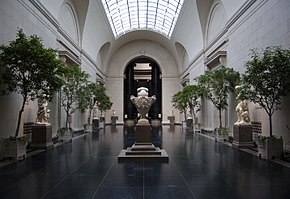
West Edifice sculpture gallery (2007)
-
West Building garden court (2010)
-

Satellite image of National Gallery of Art grounds and surrounding streets (2002)
-
Eye of Westward Building plaza, looking west towards Due west Edifice (2010)
-
Fountain in W Building plaza (2010)
-
View of fountain from concourse beneath West Building plaza (2013)
-

Center of Westward Building plaza, looking due east towards entrance of East Building (2000)
-
South face of East Edifice, looking northwest from southeast corner (2010)
-

Southwest corner of East Building, looking east (2007)
-

Southwest corner of East Edifice during renovation, looking northeast (2014)
-

Due east Building atrium (2007)
-
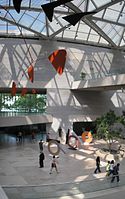
East Building atrium (2007)
Collection [edit]

Gerard van Honthorst's monumental 1623 masterwork, The Concert, was acquired by the NGA in 2013 and went on brandish for the first time in 218 years.
The NGA'due south collection galleries and Sculpture Garden display European and American paintings, sculpture, works on newspaper, photographs, and decorative arts. Paintings in the permanent collection date from the Middle Ages to the present. The Italian Renaissance drove includes two panels from Duccio'southward Maesta, the tondo of the Adoration of the Magi by Fra Angelico and Filippo Lippi, a Botticelli work on the same field of study, Giorgione's Allendale Nativity, Giovanni Bellini's The Banquet of the Gods, Ginevra de' Benci (the only painting past Leonardo da Vinci in the Americas) and groups of works past Titian and Raphael.
The collections include paintings by many European masters, including a version of Saint Martin and the Beggar, by El Greco, and works by Matthias Grünewald, Cranach the Elder, Rogier van der Weyden, Albrecht Dürer, Frans Hals, Rembrandt, Johannes Vermeer, Francisco Goya, Jean Auguste Dominique Ingres, and Eugène Delacroix, amid others. The collection of sculpture and decorative arts includes such works as the Chalice of Abbot Suger of St-Denis and a collection of work by Auguste Rodin and Edgar Degas. Other highlights of the permanent collection include the 2nd of the two original sets of Thomas Cole's series of paintings titled The Voyage of Life, (the first fix is at the Munson-Williams-Proctor Arts Institute in Utica, New York) and the original version of Watson and the Shark by John Singleton Copley (two other versions are in the Museum of Fine Arts, Boston and the Detroit Found of Arts).
The National Gallery'due south impress drove comprises 75,000 prints, in addition to rare illustrated books. Information technology includes collections of works by Albrecht Dürer, Rembrandt, Giovanni Battista Piranesi, William Blake, Mary Cassatt, Edvard Munch, Jasper Johns, and Robert Rauschenberg. The collection began with 400 prints donated past five collectors in 1941. In 1942, Joseph E. Widener donated his unabridged collection of almost 2,000 works. In 1943, Lessing Rosenwald donated his drove of 8,000 onetime master and modern prints; between 1943 and 1979, he donated near 14,000 more than works. In 2008, Dave and Reba White Williams donated their collection of more than than five,200 American prints.[27]
In 2013, the NGA purchased from a private French collection Gerard van Honthorst's 1623 painting, The Concert, which had not been publicly viewed since 1795. After initially displaying the 1.23 by two.06 m (4.0 by six.8 ft) The Concert in a special installation in the Westward Building, the NGA moved the painting to a permanent brandish in the museum's Dutch and Flemish galleries.[28] Art experts estimated the sale price of The Concert at $20 meg, though the NGA did not reveal the corporeality that it had paid.[29]
Highlights of the drove [edit]





Selected highlights from the American collection [edit]



-

-

-
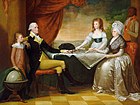
-

-

-

-

-

Thomas Cole, A View of the Mount Pass Called the Notch of the White Mountains (Crawford Notch), 1839
-

-

-

-

-
-
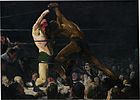
Meet also [edit]
- Collections of the National Gallery of Art
- List of original Hermitage paintings in the National Gallery of Art
References [edit]
- ^ The Fine art Paper Review, March 28,2022
- ^ The Art Paper annual museum visitor survey, published March 28,2022
- ^ Fink, Lois Marie "A History of the Smithsonian American Fine art Museum", University of Massachusetts Printing (2007) ISBN 978-1-55849-616-iii, chapter three
- ^ National Gallery of Art website: general introduction Archived December 8, 2006, at the Wayback Machine
- ^ National Gallery of Art website: chronology Archived April 7, 2010, at the Wayback Machine
- ^ a b "National Gallery of Art, West Building". American Compages. Archived from the original on 6 October 2011. Retrieved 2 October 2011.
- ^ "Cultural Landscape Inventory: The Mall (Part 2)" (PDF). U.S. National Park Service. 2006. pp. 49, 53, 72. Retrieved 2021-02-22 .
{{cite spider web}}: CS1 maint: url-status (link) - ^ "Major Giving FAQS". www.nga.gov . Retrieved 2022-04-10 .
- ^ Kerr, Euan, "Mia's director will leave to caput National Gallery", Minnesota Public Radio News, Dec xi, 2018.
- ^ McGlone, Peggy, "The National Gallery of Art will have a female managing director for the first time in its history", The Washington Post, December 11, 2018.
- ^ Greenberger, Alex (2021-05-thirteen). "Latinx Fine art Expert East. Carmen Ramos Named Chief Curator of National Gallery of Art". ARTnews.com . Retrieved 2021-08-03 .
- ^ Selvin, Claire (2019-09-27). "National Gallery of Art Names Darren Walker Trustee, Mitchell Rales Appointed President". ARTnews . Retrieved 2019-09-28 .
- ^ "National Gallery of Art". Maps and Hours. 2016-01-12. Archived from the original on 2016-01-03.
- ^ "Degas at the Opéra". National Gallery of Art. 2020-08-25.
- ^ NGA.gov Archived October 3, 2009, at the Wayback Car
- ^ Leigh, Catesby (December 8, 2009). "An Ultramodern Building Shows Signs of Age". The Wall Street Journal. Archived from the original on March 11, 2016.
- ^ "In The Tower: Barnett Newman". www.nga.gov. Archived from the original on one February 2015. Retrieved 22 September 2014.
- ^ Menachem Wecker (August 1, 2012). "His Cantankerous To Bear. Barnett Newman Dealt With Suffering in 'Zips'". The Jewish Daily Forward. Archived from the original on Feb 4, 2013. Retrieved August 8, 2012.
- ^ "Leo Villareal: Multiverse". www.nga.gov.
- ^ "About the Gallery". www.nga.gov. Archived from the original on 22 September 2014. Retrieved 22 September 2014.
- ^ "Visit: Sculpture Garden". world wide web.nga.gov. Archived from the original on 26 September 2014. Retrieved 22 September 2014.
- ^ a b c d Boyle, Katherine and Parker, Lonnae O'Neal. "National Gallery of Art Announces $30 Meg Renovation to Due east Building." Washington Post. March 12, 2013. Archived Apr 21, 2016, at the Wayback Machine Accessed 2013-03-13.
- ^ a b c d e f Boyle, Katherine. "National Gallery Sees Long-Term Benefit in Long Closing of East Building." Washington Post. March 13, 2013. Archived January half-dozen, 2018, at the Wayback Automobile Accessed 2013-03-22.
- ^ a b c Kelly, John. "Why National Gallery's East Edifice Shed Its Pink Marble Peel." Washington Post. February 21, 2012. Archived January half-dozen, 2018, at the Wayback Machine Accessed 2013-03-13.
- ^ a b c d Dietsch, Deborah K. "National Gallery of Fine art'due south Famed East Building Gets a Facelift." Washington Business organization Journal. February iii, 2012. Archived Oct 18, 2015, at the Wayback Machine Accessed 2013-03-13.
- ^ "The CIVITAS Chronicles". traditional-building.com. Archived from the original on 2015-03-23.
- ^ "Prints". Nga.gov. 2013-06-19. Archived from the original on 2013-12-21. Retrieved 2013-12-22 .
- ^ Boyle, Katherine. "National Gallery Acquires 'The Concert' by Dutch Gold Age Painter Honthorst." Washington Post. Nov 22, 2013. Archived August 29, 2017, at the Wayback Machine Accessed 2013-11-22.
- ^ Vogel, Carol "National Gallery Acquires a van Honthorst Masterwork." New York Times. November 21, 2013. Archived February 24, 2017, at the Wayback Machine Accessed 2013-11-22.
- ^ "Provenance". Nga.gov. Archived from the original on 2009-05-07. Retrieved 2013-12-22 .
Further reading [edit]
- David Cannadine, Mellon: An American Life, Knopf, 2006, ISBN 0-679-45032-7
- Neil Harris, Upper-case letter Civilisation: J. Carter Brown, the National Gallery of Art, and the Reinvention of the Museum Experience, Academy of Chicago Printing, 2013, ISBN 9780226067704
- Andrew Kelly, Kentucky by Design: The Decorative Arts, American Culture, and the Alphabetize of American Pattern, University Printing of Kentucky, 2015. ISBN 978-0-8131-5567-8
- "The National Gallery of Art, Washington", special number of Connaissance des Arts, Société Français de Promotion Artistique (2000) ISSN 1242-9198
External links [edit]
- Official website

- NGA Collection
- Department of Image Collections, National Gallery of Art Library
- Center for Advanced Written report in the Visual Arts
Source: https://en.wikipedia.org/wiki/National_Gallery_of_Art




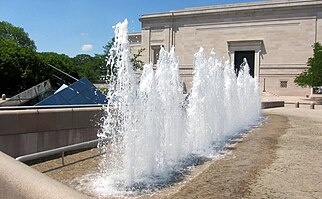
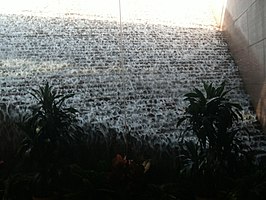



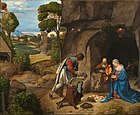


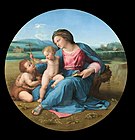

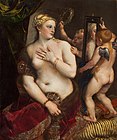


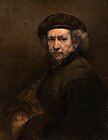














0 Response to "National Gallery of Art West Building West Garden Court"
Post a Comment